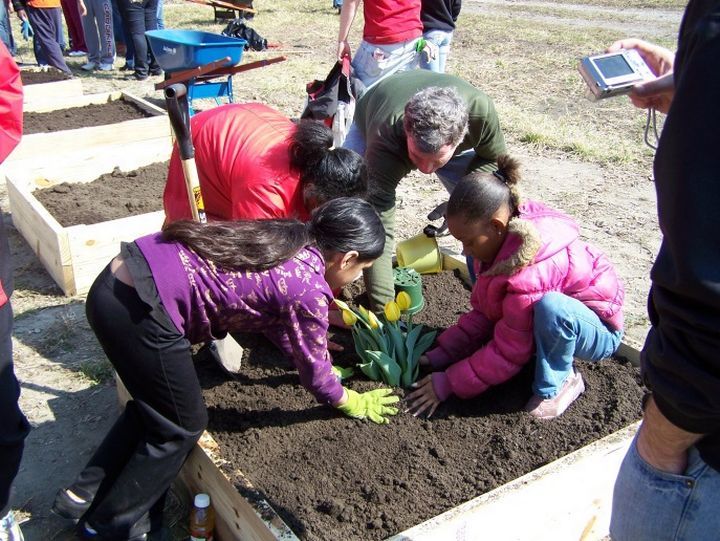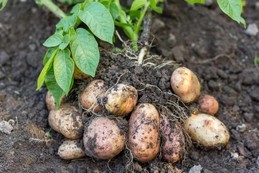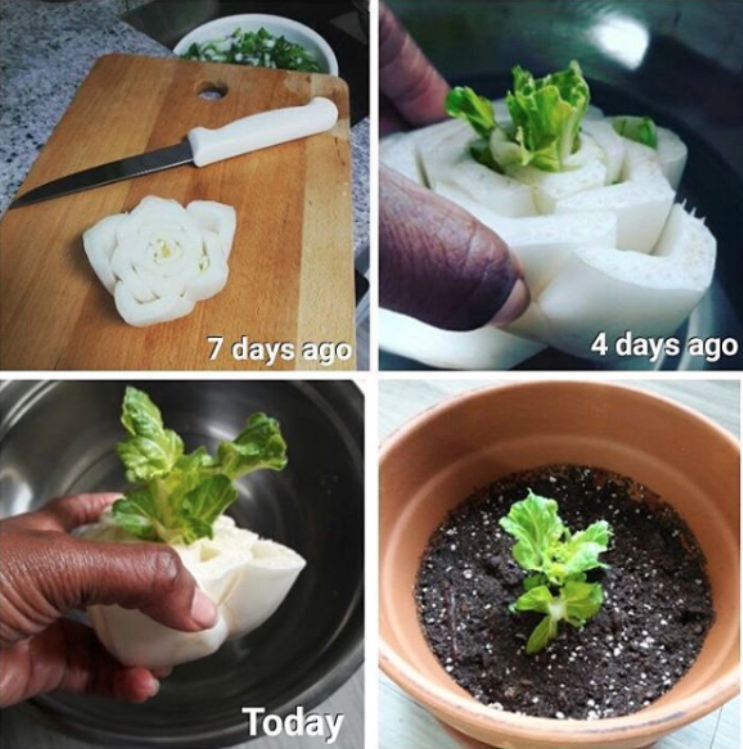Gardening with Children
"Stay at Home" Special Edition UFS Newsletter
|
|
 |
|
In this Issue:
- Gardening Basics
- Gardening Safety
- Popular Seasonal Crops
- Urban Gardening without a Lawn
- Growing from Kitchen Scraps
- Gardening Stories for Children
|
|
|

Gardening Basics
A successful vegetable garden needs clean air, moisture, lots of sun, and nutrients - also known as "food for plants" - from healthy soil. What you'll need:
Water. A source of water that is close by the garden to avoid having to carry it a long way. A gallon of water weighs a little over 8 pounds. Generally, you know you've watered enough when the soil sticks in your hand and you can form it into a ball, it is moist enough.
Light. Most vegetables need at least 6 hours of full sun per day, and more is better.
Soil. Gives plants a place to sink their roots for support, water, and minerals. The difference between soil and dirt, is soil is alive with life like bacteria, fungi, and larger critters such as worms and sowbugs. The worms and bugs help mix in air and nutrients into the soil.
Space. Vegetables need room to grow - too many plants in one space doesn't offer enough water, air, or nutrients to grow well. Seed packets usually list how much space plants need between each other.
Edible Plants. Not all vegetables grow well in Seattle. Click here for a list of vegetables with information of when to plant them. For younger children, plants with larger seeds are easier for small hands to handle, for example: beans, corn, squash.
Source: National Gardening Association, Old Farmer's Almanac
Photo: Garden at Belltown P-Patch, Seattle Parks and Recreation
|
Gardening Safety
Keeping safe in the garden is very important for children. Be prepared before heading out to the garden with adequate drinking water and appropriate clothing. Wear gloves for hand protection and sunscreen on hot days.
 Photo courtesy of MSUE
Tools
Before using tools:
- Inspect tools for defects or damage. If the tool has defects or damage, remove it from use.
- Power tools are not appropriate for children under 14.
- Children should always be supervised by an adult when using tools. Very young children should not be given sharp tools.
Using tools:
- Every tool has a dangerous side. An easy way to instruct kids is to explain that they should think of the edges- shovels, rake tines, trimmer blades – as the red zone and make sure that they are careful of the red zone of the tool.
- Tools should always be held with the red zone pointed down towards the ground.
- When putting a tool down, the cutting edge (or red zone) should be close to the ground – rakes should be put with tines down – as should forks, hoes, and shovels.
- Tools are not toys and there is no horseplay allowed with tools.
- Kids should also be aware of the danger that long handles can pose. Tools are not batons to be swung around or swords or stilts. Neither should tools be thrown, left on the ground, or put in pockets.
- Make sure a child allows adequate room when using a tool to prevent injury to others
- Use tools away from your own body and look where you are going to make sure it is away from everyone else’s body too.
- Use the proper hand tool for the work you are doing. Using the wrong tool for the job can result in more force being used and danger for the user.
After using tools:
- Tools should be cleaned and put away after use in their proper location.
- In some cases, tools should be disinfected to prevent cross contamination.
- Hoses should be rolled up to prevent tripping.
Note: Garden chemicals, including fertilizers and pesticides, should not be used by children – please keep them away from children in a secure and properly ventilated storage area.
Source: Michigan State University Extension
|
|
Photo courtesy of Old Farmer's Almanac
LETTUCE
|
|
 Photo courtesy of Daily Gardener
POTATOES
|
|
|
|
Gardening is a wonderfully rewarding experience and a great way to add healthy and organic food to your family’s meals. Many people would love to garden, but have little to no yard space for a traditional garden.Gardeners with a sprawling yard have a leg up but thankfully, innovative gardeners can turn almost any space into a growing area.
 Photo courtesy of San Diego Seed Company
- Grow what you can indoors using pots or containers
- Containers require less water than in-ground planting
- Plants are portable and can be moved around according to their sunlight needs
- A wide variety of herbs and salsa ingredients do well in small windowsill pots.
- Consider plants that climb
- Tomatoes, beans, peas, cucumbers and some varieties of squash grow can be grown vertically to use less space on a patio, balcony or even indoors.
- Plant companions together
- Find a patch of fertile soil near your apartment complex or in a community garden.
More tips for gardening without outdoor space here.
A great way to limit grocery store trips, save money, and cut down on waste is to grow food yourself. You can re-grow certain produce from scraps that you would normally compost or throw away.
 Photo courtesy of Instagram: @theatricalpace
Be sure to start by buying organic if you are able. Avoid anything treated with growth retardants; these are used to prevent sprouting in grocery stores.
-
Stems regrow if the bottom of the vegetable is intact. Think bok choy (pictured above), cabbage, celery, green onions, fennel, kohlrabi, leeks, lemongrass, and lettuce.
-
Herbs regrow from stem cuttings. Try basil, cilantro, lemon balm, mint, oregano, parsley, sage or thyme.
-
Root veggies regrow from leafy tops.Save the tops of your beets, carrots, parsnips, radishes, rutabagas and turnips.
-
Tuberous roots & stems need the entire plant. Try sprouting new growth from the eyes of sweet potatoes, cassava, potatoes, and yams.
- And of course, there's good old fashioned seed starting. Plant the seeds of lemons, limes, tangerines, hot and red peppers, tomatoes, pumpkins. Keep in mind that fruit trees may need a cold, moist period or cross pollination to produce fruit.
Lola Plants a Garden
by Anna McQuinn
Lola plants a flower garden with her parent's help, and watches it grow. Available in e-book format at Seattle Public Library.
The Ugly Vegetables
by Grace Lin
A little girl thinks her mother's garden is the ugliest in the neighborhood until she discovers that flowers might look and smell pretty but Chinese vegetable soup smells best of all. Includes a recipe. Available in e-book format at Seattle Public Library.
|
|
|
|
|